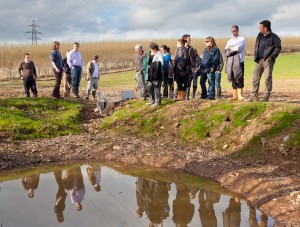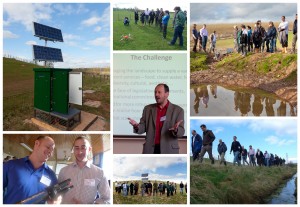Demonstration Test Catchments: A Joint SWIG and EdenDTC meeting
The joint Sensors for Water Interest Group (SWIG) and EdenDTC workshop brought together over 40 delegates at the Newton Rigg Campus, University of Cumbria, where a series of presentationsand practical demonstrations were held in the morning, followed by a field tour of the Newton Rigg demonstration farm platform in the afternoon. An introduction to the EdenDTC was provided, detailing the research platform and hardware that captures real time evidence needed to understand the interaction of land use with water and, hence, develop improved and more sustainable approaches to farm management within catchments. Presentations focused on practical applications and covered impacts of legislation, contaminant mobilisation concerns and an update on the development of guidelines for flood risk mapping. Other contributions comprised a presentation of real time high resolution catchment monitoring, including a live demonstration; an introduction to the use of unmanned aerial vehicles (UAVs) and cloud computing methods for spatial diffuse pollution risk assessment; and a catchment-monitoring case study from the Mires Project, with a live interactive session, to show how wireless remote monitoring can overcome challenges related to power supply, network coverage, physical size, control and the ability to provide real-time data.

“Having set up a diffuse pollution project in Jersey, I was very pleased to be invited to attend the joint SWIG/EdenDTC meeting. The presentations were very interesting and informative, moving from a general overview of the DTC platform to detailed discussion of the technology available for real-time water quality monitoring. The afternoon catchment tour included visits to both monitoring sites, as well as an example of a mitigation measure, which helped add context to the morning talks.” Kate Roberts, States of Jersey
The catchment and farm tour included a visit to a newly installed water sampling station, where Matt Loewenthal (EA) provided a comprehensive demonstration of the instrumentation; a tour of the farm to see various mitigation measures in place; a visit to the weather station combined with a demonstration of the UAV by Sim Reaney (Durham Univeristy), to demonstrate how monitoring from the air can provide invaluable data to compliment water-based measurements; and also a trip to the Mitigation Options for Phosphorous and Sediment (MOPS) ponds.

Images clockwise from top left: Newly installed water monitoring station at Newton Rigg; demonstration of the UAV; discussion at the MOPs ponds; delegates walking between sites; instrumentation demonstration at the Newton Rigg outlet site; showcasing of water monitoring equipment. Central image: Professor P Haygarth introduces the DTC.
Programme
Chairman: Phil Haygarth, Project Leader, EdenDTC
Introduction to the workshop and to the EdenDTC
Phil Haygarth, Lancaster Environment Centre and Project Leader EdenDTC
Real Time High Resolution Catchment Monitoring – a Live Demonstration
Matt Lowenthal, Manager of the Environment Agency’s Catchment Monitoring Network
Matt Dibbs, General Manager, Meteor Communications
Science in the Clouds: UAVs and Cloud Computing Methods for Spatial Diffuse Pollution Risk Assessment
Dr Sim Reaney, RCUK Research Fellow, Department of Geography and Institute of Hazard & Risk Research, Durham University
Planning for Potential Changes in Land Management Practices and Policies (report on UKWIR research)
Liz Buchanan, Principal Consultant, Entec UK Ltd
Real-time monitoring and control for Wireless Remote Monitoring Networks – The Mires Project
Rob Stevens, Managing Director, RS Hydro